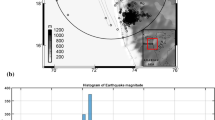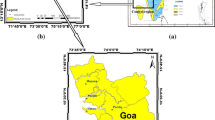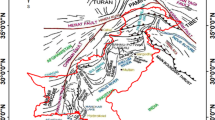Abstract
Gujarat is one of the fastest-growing states of India with high industrial activities coming up in major cities of the state. It is indispensable to analyse seismic hazard as the region is considered to be most seismically active in stable continental region of India. The Bhuj earthquake of 2001 has caused extensive damage in terms of causality and economic loss. In the present study, the seismic hazard of Gujarat evaluated using a probabilistic approach with the use of logic tree framework that minimizes the uncertainties in hazard assessment. The peak horizontal acceleration (PHA) and spectral acceleration (Sa) values were evaluated for 10 and 2 % probability of exceedance in 50 years. Two important geotechnical effects of earthquakes, site amplification and liquefaction, are also evaluated, considering site characterization based on site classes. The liquefaction return period for the entire state of Gujarat is evaluated using a performance-based approach. The maps of PHA and PGA values prepared in this study are very useful for seismic hazard mitigation of the region in future.











Similar content being viewed by others
References
Aki K (1965) Maximum likelihood estimate of b in the formula log N = a-bm and its confidence limits. Bulletin of Earthquake Research Institute 43:237–239
Anbazhagan P, Vinod JS, Sitharam TG (2009) Probabilistic seismic hazard Analysis for Bangalore. Journal of Natural Hazards 48(2):145–166
Atkinson GM, Boore DM (2006) Earthquake ground-motion prediction equations for Eastern North America. Bull Seismol Soc Am 96(6):2181–2205
Bender B (1983) Maximum likelihood estimation of b values for magnitude grouped data. Bull Seismol Soc Am 73:831–851
BIS-1893 (2002) Indian standard criteria for earthquake resistant design of structures. Part 1—general provisions and buildings. Bureau of Indian Standards, New Delhi
Biswas SK (1987) Regional tectonic framework, structure and evolution of the western marginal basins of India. Tectonophysics 135:307–327
Bommer JJ, Scherbaum F, Bungum H, Cotton F, Sabetta F, Abrahamson NA (2005) On the use of logic trees for ground-motion prediction equations in seismic hazard analysis. Bull Seismol Soc Am 95:377–389
Boominathan A, Dodagoudar GR, Suganthi A, Uma Maheswari R (2008) Seismic hazard assessment of Chennai city considering local site effects. J Earth Syst Sci 117(S2):853–863
BSSC (2001) NEHRP Recommended provisions for seismic regulations for new buildings and other structures, 2000 Edition, part 1: provisions, prepared by the building seismic safety council for the federal emergency management agency (Report No. FEMA 368), Washington
Budnitz RJ, Apostolakis G, Boore DM, Cluff LS, Coppersmith KJ, Cornell CA, Morris PA (1997) Recommendations for probabilistic seismic hazard analysis: guidance on uncertainty and use of experts. US Nuclear Regulatory Commission Report, NUREG/CR- 6372
Campbell KW, Bozorgnia Y (2003) Updated near-source ground motion (attenuation) relations for the horizontal and vertical components of peak ground acceleration and acceleration response spectra. Bull Seismol Soc Am 93:314–331
Cornell CA (1968) Engineering seismic risk analysis. Bull Seismol Soc Am 58:1583–1606
Cramer CH, Kumar A (2003) 2001 Bhuj, India, earthquake engineering seismoscope recordings and Eastern North America ground motion attenuation relations. Bull Seismol Soc Am 93:1390–1394
Crespo MJ, Martin J (2002) The use of zoneless method in four LNG sites in Spain. 12th European Conference on Earthquake Engineering, Paper Ref. 306, Elsevier Science Ltd
Frankel A (1995) Mapping seismic hazard in the Central Eastern United States. Seismol Res Lett 66(4):8–21
Gosavi PD, Bapat AV, Guha SK (1977) Maeroseismic studies of four reeenl Indian earthquakes. Proc World Conf Earthquake Engg 1:49–54
GSI (2000) Seismotectonic Atlas of India. Geological Survey of India, Kolkata
Gubin IE (1968) Seismic zoning of Indian peninsula. Bulletin of the International Institute of Seismology and Earthquake Engineering 5:109–139
Gutenberg B, Richter CF (1954) Seismicity of the earth and associated phenomena, 2nd edn. Princeton University Press, Princeton, p 310
Hardas MG (1980) Textural parameters and depositional processes of the sub-surface Serau Formation, Cambay basin. J Palaeontol Soc India 25:106–109
Iyengar RN, Ghosh S (2004) Microzonation of earthquake hazard in greater Delhi area. Curr Sci 87:1193–1202
Jaiswal K, Sinha R (2007) Probabilistic seismic-hazard estimation for peninsular India. Bull Seismol Soc Am 97(1B):318–330
Joshi JP, Bisht RS (1994) India and the Indus Civilization. National Museum Institute, New Delhi
Kaila KL, Krishna VG, Mall DM (1980) Crustal structure along Mehmadabad-Billimora profile in the Cambay basin, India, from deep seismic soundings. Tectonophysics 76:99–130
Kalkan Erol, Gülkan Polat, Yilmaz Nazan, Çelebi Mehmet (2009) Reassessment of probabilistic seismic hazard in the Marmara Region. Bull Seismol Soc Am 99(4):2127–2146
Kayal JR, Mukhopadhyay S (2006) Seismotectonics of the 2001 Bhuj earthquake (Mw 77) in western India: constraints from aftershocks. J Ind Geophys Union 10(1):45–57
Kelkar YN (1968) Earthquakes experienced in Maharashtra during the last 300 years. Daily Kesari Poona, Marathi
Kijko A (2004) Estimation of the maximum earthquake magnitude, m max. Pure Appl Geophys 161:1655–1681
Kijko A, Sellevoll MA (1989) Estimation of earthquake hazard parameters from incomplete data files. Part I: utilization of extreme and complete catalogues with different threshold magnitudes. Bull Seismol Soc Am 79:645–654
Kijko A, Sellevoll MA (1992) Estimation of earthquake hazard parameters from incomplete data files: part II. incorporation of magnitude heterogeneity. Bull Seismol Soc Am 82:120–134
Kramer SL, Mayfield RT (2007) Return period of soil liquefaction. J Geotechn Geoenviron Eng 133(7):802–813
Lapajne J, Motnikar BS, Zupancic P (2003) Probabilistic seismic hazard assessment methodology for distributed seismicity. Bull Seismol Soc Am 93(6):2502–2515
Mandal P, Kumar N, Satyamurthy C, Raju IP (2009) Ground-motion attenuation relation from strong-motion records of the 2001 Mw 7.7 Bhuj earthquake sequence (2001–2006). Gujarat. Pure Appl Geophys 166:451–469
Martin C, Secanell R, Combes Ph, Lignon G (2002) Preliminary probabilistic seismic hazard assessment of France. In: 12th european conference on earthquake engineering, Paper Ref. 870, Elsevier Science Ltd
Menon A, Ornthammarath T, Corigliano M, Lai CG (2010) Probabilistic seismic hazard macrozonation of Tamil Nadu in Southern India. Bull Seismol Soc Am 100:1320–1341
Milne J (1911) A catalogue of destructive earthquakes, A.D. 7 to A.D. 1899. British Association of Advancement of Sciences, London 92
Nath SK (2006) Seismic hazard and microzonation atlas of the sikkim himalaya. Department of Science and Technology, Government of India, India
Oldham TA (1883) Catalogue of Indian earthquakes. Mem Geol Survey India 19:163–215
Pande P, Kayal JR, Joshi YC, Ghevariya (2003) Lithotectonic frame work of Gujarat and adjoining regions. Kutch (Bhuj) Earthquake 26 January, 2001. Ed. P. Pande and J.R. Kayal. Geol Surv Sp Pub 76:5–9
RaghuKanth STG, Iyengar RN (2006) Seismic hazard estimation for Mumbai city. Curr Sci 91(11):1486–1494
RaghuKanth STG, Iyengar RN (2007) Estimation of seismic spectral acceleration in peninsular India. J Earth Syst Sci 116(3):199–214
Rajendran K, Rajendran CP, Thakkar M, Tuttle M (2001) The 2001 Kutch (Bhuj) earthquake: coseismic surface features and their significance. Curr Sci 80(11):1397–1405
Rajendran CP, Rajendran K, Thakkar M, Goyal B (2008) Assessing the previous activity at the source zone of the 2001 Bhuj earthquake based on the near source and distant paleoseismological indicators. J Geophy Res 113(B05311):1–17
Reasenberg P (1985) Second-order moment of central California seismicity 1969–82. J Geophys Res 90:5479–5495
Scordilis EM (2006) Empirical global relations converting ms and mb to moment magnitude. J Seismolog 10:225–236
Sitharam TG, Vipin KS (2011) Evaluation of spatial variation of peak horizontal acceleration and spectral acceleration for south India: a probabilistic approach. Nat Hazards 59(2):639–653
Srivastava HN, Ramachandran K (1983) New catalogue of earthquakes for Peninsular India during 1839–1900. Mausam 36(3):351–358
Stepp JC, Wong I, Whitney J, Quittemeyer R, Abrahamson N, Toro G, Youngs R, Coppersmith K, Savy J, Sullivan T (2001) Yucca mountain PSHA project members, probabilistic seismic hazard analyses for ground motions and fault displacements at Yucca Mountain, Nevada. Earthq Spectra 17:113–151
Talwani P, Gangopadhyay A (2001) Tectonic framework of the Kachchh earthquake of 26 January 2001. Seismol Res Lett 72:336–345
Turner HH (1911) Seismological investigations XII, seismic activity, 1899–1903 inclusive. British Association for the Advancement of science, 16th Report, pp 57–65
Utsu T (1999) Representation and analysis of the earthquake size distribution: a historical review and some new approaches. Pageoph 155:509–535
Vilanova SP, Fonseca JFBD (2007) Probabilistic seismic-hazard assessment for Portugal. Bull Seismol Soc Am 93(6):2502–2515
Vipin KS, Sitharam TG (2011) Evaluation of liquefaction return period based on local site classes: probabilistic performance based logic tree approach. Int J Geotech Eng 5:245–254
Vipin KS, Anbazhagan P, Sitharam TG (2009) Estimation of peak ground acceleration and spectral acceleration for South India with local site effects: probabilistic approach. Nat Hazards Earth Syst Sci 9:865–878
Vipin KS, Anbazhagan P, Sitharam TG (2010) Probabilistic evaluation of seismic soil liquefaction potential based on SPT data. Nat Hazards 53:547–560
Wahlstrom E, Grunthal R (2000) Probabilistic seismic hazard assessment (horizontal PGA) for Sweden, Finland and Denmark using different logic tree approaches. Soil Dyn Earthq Eng 20:45–58
Wiemer S, Wyss M (2000) Minimum magnitude of complete reporting in earthquake catalogs: examples from Alaska, the Western United States, and Japan. Bull Seismol Soc Am 90:859–869
Woo G (1996) Kernel estimation methods for seismic hazard area source model. Bull Seismol Soc Am 86(2):253–362
Yadav RBS, Tripathi JN, Rastogi BK, Chopra S (2008) Probabilistic assessment of earthquake hazard in Gujarat and adjoining region of India. Pure Appl Geophys 165:1813–1833
Acknowledgments
The first author acknowledges the funding received from Indian Institute of Science, Bangalore, in the form of Senior Research Fellowship for carrying out this work. The authors also thank Ministry of Earth Sciences, New Delhi, for funding the project “Site Characterization of Indo Gangetic Plain (Lucknow and Kanpur) with Studies on Site Response and Liquefaction”, and the Space Technology Cell, IISc Bangalore, for Funding the project “Assessment of Seismicity of Peninsular India—Using Remote Sensing and GIS”.
Author information
Authors and Affiliations
Corresponding author
Rights and permissions
About this article
Cite this article
Vipin, K.S., Sitharam, T.G. & Kolathayar, S. Assessment of seismic hazard and liquefaction potential of Gujarat based on probabilistic approaches. Nat Hazards 65, 1179–1195 (2013). https://doi.org/10.1007/s11069-012-0140-6
Received:
Accepted:
Published:
Issue Date:
DOI: https://doi.org/10.1007/s11069-012-0140-6




